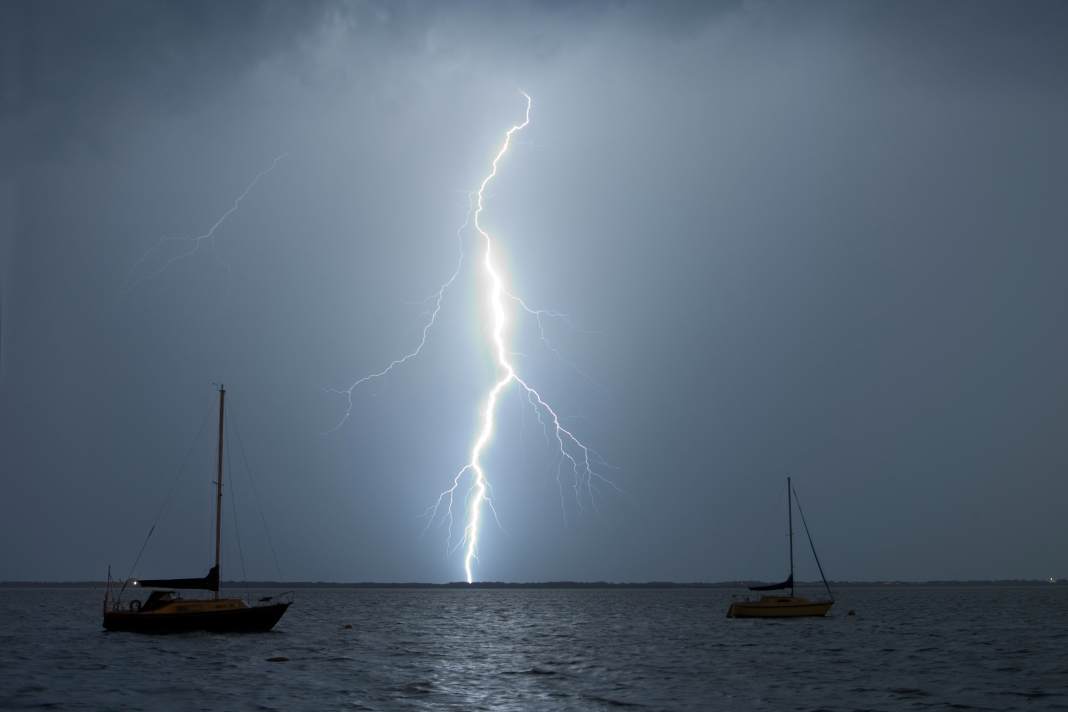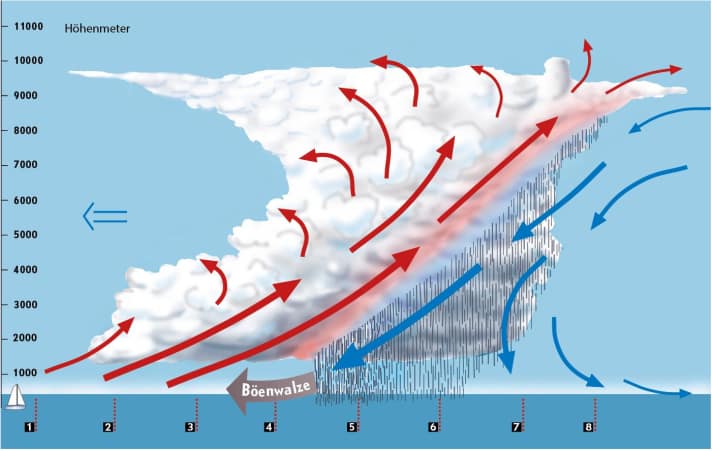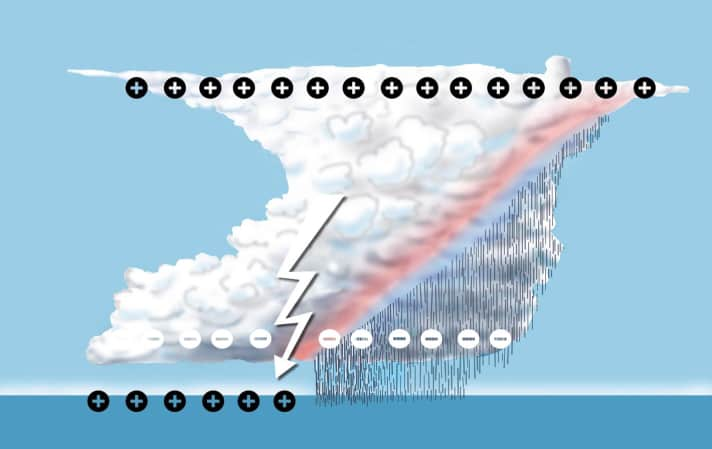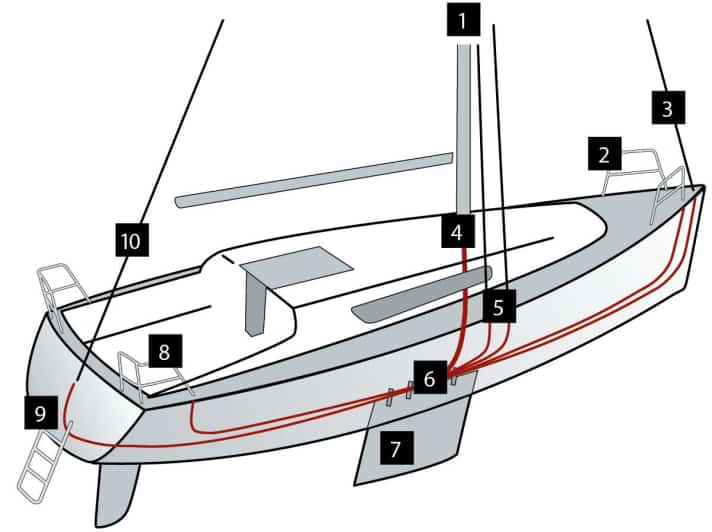Knowledge: Danger of thunderstorms, how can sailors protect themselves?




Stormy mood. A term that serves as a metaphor for the unstable calm in which a storm seems unavoidable. It symbolises a tense atmosphere that makes it difficult to breathe. It symbolises impending change, the course of which is just as uncertain as the question of whether or not it will cause lasting damage. A stormy atmosphere symbolises fear and uncertainty and - worst of all - a hopeless situation.
According to an old rule of thumb, the most effective protection during thunderstorms is to avoid being outdoors. To hide away. A tip that is not worth much at sea, however. No one can hide from reality here, different rules apply. If you know them and heed them in good time, you still won't be able to escape the storm. But at least they can look forward to it much more calmly.
More on the topic:
Wichte rules for thunderstorms at sea
- Reefing sails In the open sea, thunderstorms usually mean strong winds. The ship and crew must be prepared for this.
- Start engine Should its electrical system fail due to a lightning strike, a running diesel is still fully functional.
- Lightning protection If a mobile device is on board, it is deployed.
- Hold ship location If the electronics fail, the coupling can be continued with the last fix.
- Secure crew All persons should be below deck, but keep their distance from the mast base. The helmsman wears insulating clothing and does not touch metal parts with bare hands.
- Be prepared Have fire extinguishers and signalling equipment ready. Disconnect electronic devices from the vehicle electrical system and, if possible, place them in a metal box or in the oven.
- Avoiding manoeuvres Anchoring and sailing manoeuvres are an absolute taboo, as metal parts carrying lightning currents may have to be touched.
- In the harbour Remove and stow the shore power cable and conductive mooring lines.
The first step is to reduce the sail area. The wet sails and the metal parts of the rig should not be touched later in the charged atmosphere. Then the machine is started. It is now ready for use before its electrical system is damaged in a thunderstorm.
We are now clearing up on deck. Everything that is not secure is stowed or lashed down. Stretching straps are fastened, the seaworthy condition is established - hatches, windows, ventilators, sea valves, companionway and other boat-specific openings are closed. The cockpit bilge pump is checked for patency and the pumps are checked for serviceability. The crew goes below deck, the helmsman puts on heavy weather gear.
The location is determined and noted in the map and logbook. In the event that the navigation electronics fail, the navigator prepares to dock. And it is not an exaggeration to announce a location ashore and to have fire extinguishers and rescue equipment ready.
Apart from the uncertainties that come with fast-approaching strong winds, thunderstorms also have their own horrors. These include, for example, sudden wind shifts of up to 180 degrees. Extremely poor visibility must be expected. The sea becomes rough from one moment to the next. And finally: a lightning strike.
Lightning occurs as a result of different charges within the thundercloud (see diagram below). These are negatively charged on their underside and positively charged in the upper area and on the ground below the cloud. The equalisation leads to current surges of several million volts, an average voltage of 20,000 amperes and a speed of 10,000 to 100,000 kilometres per second.
They are visible in the form of lightning and can be heard as thunder, either from cloud to cloud or from cloud to earth. But not much more is known. The worst thing about this phenomenon is therefore its unpredictability. Whether the lightning will strike, where it will strike and what will happen is simply unpredictable. Everything that has been said and published about this has the character of rules of thumb.
There is still a consensus among experts that lightning strikes preferentially in elevated objects that are highly conductive and have a connection to the earth. Applied to a sailing yacht, this means that lightning would preferably strike in the area from the masthead to the spreaders. However, if the yacht is shifting, spreaders, shrouds or stays could also become lightning strike points.
How thunderstorms develop
A distinction is made between thermal thunderstorms and frontal thunderstorms.
Heat storm
Heat thunderstorms usually occur on land in the second half of a hot summer day. The earth's surface gradually warms up, the air becomes warm and moist - humid - and rises. At altitude, the air is considerably colder. When this difference reaches the so-called trigger temperature, thunderstorms occur.
Thermal thunderstorms only occur over water in rare cases and then at night. The classic summer thunderstorm therefore mainly affects inland areas. If the sailor has to deal with lightning and rolling thunder at sea, it is usually a frontal storm. These are far more unpleasant because they are accompanied by violent gusts of wind.
Frontal thunderstorm
As the name suggests, frontal thunderstorms occur when the cold air of a passing front pushes under the warm, humid air. The rest of the process is the same for both types of thunderstorm. All the phenomena associated with them are based on what happens in a cumulonimbus, a thundercloud.
Before a typical summer thunderstorm on land, the formation of the thundercloud is easy to observe. It slowly forms from the swelling cumuli, the fair weather clouds. These grow like towers and fray towards the top. The result is a veritable anvil. This also reveals the direction of the thunderstorm. This is because it is blown out in the direction of the wind, and that is the direction in which it is travelling - with the wind. However, the wind can blow very differently up there than it does near the earth's surface.
Typical course of a thunderstorm

- Slump The wind dies down almost completely. It becomes hazy. Clouds accumulate.
- Wind shifter It is blowing from a completely different direction than a short time before.
- Gust roller A black bulge of cloud appears behind the chine. Even before it reaches the ship, it is battered by a gust of well over 6 Beaufort.
- Heavy rain Heavy rain, sometimes hail, comes from the black underside of the thundercloud.
- Thunder and lightning The discharge of the structure manifests itself as lightning between the clouds or between the clouds and the earth, which can be heard as thunder.
- Cooling down The air cools drastically as a result of the thunderstorm.
- Gusty strong wind The wind remains fierce, its strength and direction unsteady.
- Reassurance At some point, calm finally returns.
From a physical point of view, all types of thunderstorm work in the same way: warm air flows upwards more and more violently in the cloud, while cold air literally shoots downwards alongside it. This leads to various effects: In front of the dark underside of the thunderstorm tower, the cold air escapes in a powerful gust roller. Heavy rain showers fall directly below, and there may even be hail. Lightning and thunder are always present. The air cools drastically and the wind blows strongly from changing directions before the weather finally calms down again.
In addition to clouds, indications of thunderstorms are distant flashes of lightning, which are perceived as weather lightning. In addition, thick layers of haze often form. The southern and western quadrants should be watched carefully for such signs. This is the direction from which thunderstorm clouds usually rise in our areas.
How lightning is created

Recognising thunderstorms

Via Internet
Thunderstorms are easy to recognise in the many internet services and apps available for this purpose. They are very good at showing the severity, direction and timing of thunderstorms.
By radio
If you like it more old-fashioned or don't have an internet connection, you can switch on the radio on medium wave. Irregular crackling also indicates a thunderstorm in the vicinity.
With rule of thumb
If lightning and thunder can be heard, the distance of the thunderstorm can also be determined - because the sound travels 330 metres per second. The seconds between lightning and thunder divided by three therefore give the distance in kilometres.
As easy as it is to recognise thunderstorms on and over land, it is just as difficult to spot the squall line of a frontal thunderstorm at sea. The associated dark cloud bulge can often only be recognised ten to 15 minutes before the storm breaks out because it lies so low and only emerges late behind the horizon. During this time, the crew must prepare themselves and their ship for gusts beyond 6 Beaufort.
How dangerous lightning is for yachts
It is extremely rare for lightning to strike a yacht. Most damage to boats caused by lightning is caused by induced voltages, which always occur when lightning strikes nearby - usually in the water. This damage usually involves destroyed electronics, not structural damage to the yacht.
In the rare event that lightning does find its way into the boat via the rig, various scenarios are conceivable. All of them are based on the fact that the lightning ultimately finds its way into the water. If it is not effectively diverted there, damage usually occurs. These range from the failure of the entire electronics to cable fires and even entire holes in the hull.
There are effective precautions that divert lightning into the water and thus prevent damage to the ship and crew. From a technical point of view, a distinction must be made between different measures.
Discharge the lightning
Firstly, a good down conductor must be provided. If the mast is made of aluminium, it can serve as a lightning arrester itself. If it is made of wood, it must be equipped with a sufficiently thick conductive cable and a lightning arrester in the top. This also makes sense on an aluminium rig if it towers above the antenna forest and there is therefore a chance that the lightning will not strike there and cause damage.
The mast, shrouds, stays and bow and stern pulpit must be carefully earthed as possible points of impact.

- Masthead A lightning arrester should protrude about 30 centimetres above the antennas. On wooden masts, it is connected to the keel or earthing plate via a 16-square-millimetre cable.
- Pulpit Is directly earthed with 16 square millimetre cable.
- Forestay Is directly earthed with 16 square millimetre cable.
- Mast base This is where the main load comes together in an emergency. It is earthed with a 35-square-millimetre cable.
- Püttinge The putties are folded together and earthed with a 16-square-millimetre cable on each side.
- Keel bolt If the metal keel is used for earthing, all earthing cables run together here.
- Metal keel An under-bolted keel made of lead or iron is the best lightning conductor. However, it must not be completely isolated from the water by sealing.
- Rear basket Is directly earthed with 16 square millimetre cable.
- Swimming ladder Is folded into the water and earthed in the boat and thus acts as an additional down conductor.
- Backstay Is directly earthed with 16 square millimetre cable.
On metal ships, this lightning grounding occurs without further action. Due to the material, if the lightning strikes the rig, it finds its way into the water via the hull. And the crew of steel or aluminium yachts have another advantage: They are inside a Faraday cage and are therefore safe from direct lightning strikes.
The situation is different on wooden or plastic yachts, where the lightning earth must first be installed. The shipyard often omits this and only installs an earthing via the shrouds. What to do in individual cases should be discussed with an expert on board, as every yacht has its own peculiarities.
However, the principle is always the same: shrouds, stays, mast, bow and stern pulpit are connected to the water using suitable cables and clamps. This can be done via the keel bolts if the metal keel is not sealed by a watertight GRP or paint structure, or via the connection to an earthing plate. This should be attached to the outside of the hull and have a surface area of at least half a square metre - the larger the better.
The conductor cross-section suitable for lightning current for components carrying lightning current is 8 square millimetres for copper and 16 square millimetres for aluminium. A compromise of the "better than nothing" variety is a strong copper cable pulled under the keel and fastened tightly to the mast and stays with clamps.
Be careful with DIY lightning protection: If everything is not wired properly, you can quickly create a "battery". If the boat is then exposed to salt water, corrosion can occur at various points in the wiring.
A further step in effective lightning protection is the potential equalisation of all metal components that are not connected to the lightning earth. These can be railing supports, the steering column, the engine, tanks, rudder cokers and the like.
These components should be connected to the collective line of the ship's operating earth in order to avoid different voltages being equalised via the crew members who touch them. This is because it can be assumed that these parts will be charged to different degrees by stray voltage as a result of a lightning strike and that this voltage must be dissipated. Of course, the entire installation also has disadvantages, as it requires maintenance and is only effective if the conductivity is not impaired due to creeping corrosion. It also promotes electrical corrosion and pitting.
Last but not least, the protection of sensitive electronics deserves attention. It is quickly destroyed; inductive interference is sufficient when lightning strikes in the vicinity. This can only be remedied by a complete package of measures. It starts with shielding the cables with metal cable ducts. Then lightning current and surge arresters must be installed, both on the mains and on the signalling lines. Devices that can be dismantled are stored in tin cans or the oven during thunderstorms.
Anyone who has done everything that can be done can be doubly reassured if they get caught in a thunderstorm at sea. Firstly, because statistically speaking, winning the lottery is more realistic than being struck by lightning while travelling. Secondly, because well-installed lightning protection is highly likely to prevent the worst possible damage to the ship.

